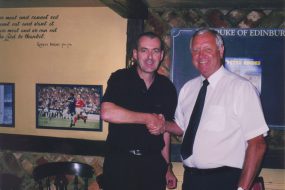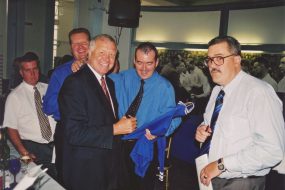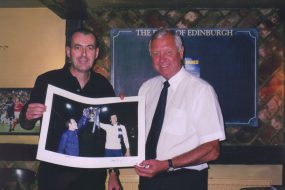Peter Osgood, the ‘King of the Bridge’, is a hero at Stamford Bridge. The Duke was lucky enough to see Peter Osgood on a number of occasions, with the formal visit the most memorable. Shirt signing and stories of his days at the Bridge were offered to regulars.
Known as ‘Ossie’, he played for Chelsea FC from 1965 to 1974, and then again from 1978 for a year before retiring in 1979. Born Peter Leslie Osgood (20 February 1947 – 1 March 2006), Ossie’s career spanned from the early 1960s and in to the late 1970s. He is best remembered for representing Chelsea FC, and then Southampton, and was also capped four times by England in the early 1970s.
Chelsea
Born in a small road named Kentons Lane in Windsor, Osgood was signed by Chelsea as a junior and made his debut as a 17 year-old in the League Cup, scoring both goals in a 2-0 win against Workington AFC on 16 December 1964. The buzz surrounding the tall, skilful teenager’s goalscoring for the club’s reserves – 30 goals in 20 games going into that month – was already immense and it was only a matter of time before he became a regular first-teamer.
Following an end-of-season tour of Australia during which Osgood scored 12 times in eight games, the centre-forward’s next senior match was the 22 September 1965 4-1 victory over AS Roma in the Inter-City Fairs Cup (a violent encounter dubbed “the Battle of the Bridge”). A run in the league followed, bringing seven goals, including one involving a 60-yard run past a trail of Burnley players.
The teenager was soon hailed as a possible late call-up for Alf Ramsey’s 1966 World Cup squad, having been included in the original 40-man squad announced in April 1966, but he was not included in the final 22. He was taken to the hearts of the Chelsea faithful, who nicknamed him “the Wizard of Os”.
A broken leg suffered in a challenge by Blackpool’s Emlyn ‘Crazy Horse’ Hughes in the League Cup on 6 October 1966 seriously curtailed his progress, and he missed Chelsea’s first-ever Wembley FA Cup final on 20 May 1967. Without him the Blues lost to Tottenham Hotspur 1-2.
It was a major disappointment for this big-stage player yet ‘Ossie’ returned from the injury an equally graceful – if tougher – player. His vision and physical presence were recognised by new manager Dave Sexton playing him often as a midfielder, notably wearing the number 4 shirt for most of the 1968-69 season (reference page 70 ‘Ossie – King of Stamford Bridge’ written with Martin Knight and Martin King ), but it is as a goal scoring centre-forward, number 9, that he is best remembered. In total, Osgood made 380 appearances for The Blues, scoring 150 goals. He was one of only nine players to score in every round of the FA Cup (and, to date, the last to do so), helping Chelsea to victory in a replayed final against Leeds United in 1970. He scored Chelsea’s equaliser in the second game at Old Trafford with a diving header from Charlie Cooke’s chipped pass twelve minutes from full time; his side eventually won 2-1.
In 1971, Osgood was part of the Chelsea team which lifted the European Cup Winners’ Cup, defeating Real Madrid 2-1 in a replay in Athens after the original tie had finished 1-1, with Osgood scoring Chelsea’s goal in that game. In the replay he scored again, the opener, as they went on to win 2-1. In 1972, he scored for Chelsea in a major cup final for the third consecutive year – this time the League Cup – though they lost 1-2 to Stoke City. Chelsea declined as a major force thereafter, but Osgood continued to score regularly; his volley from outside the area against Arsenal in the FA Cup quarter-final was voted goal of the season in 1972-73.
Southampton, Norwich and return to Chelsea
Following a series of disagreements with manager Dave Sexton over his lifestyle (during which supporters picketed Stamford Bridge to demand he stay) Osgood, along with several of his team-mates, was dropped from the squad and placed on the transfer list. He was sold to Southampton in March 1974 for a club-record £275,000. During his time on the south coast, he won the FA Cup again in 1976 after a 1-0 victory over Manchester United. He left Southampton in November 1977, shortly before the club were promoted. He scored 36 goals in 157 games for the Saints. Towards the end of his career, he also had a brief loan spell at Norwich City. Osgood returned to Chelsea in December 1978 following a disappointing stint in the United States with the Philadelphia Fury, where he scored only 1 goal in 23 matches for a team which also included Alan Ball and Johnny Giles. On his return to Stamford Bridge, the club were in deep decline and facing a relegation battle. He again scored on his debut to put his team ahead, though Chelsea still lost 7-2 to Middlesbrough. He stayed with the club for the rest of the season before retiring in December 1979.
England
In spite of his talent and goal scoring prowess, Osgood’s England career was surprisingly limited, with England manager Alf Ramsey apparently disapproving of his playboy lifestyle. As a result, he only won four international caps, without scoring. Osgood made his England debut in February 1970 in a 3-1 win over Belgium. He was a member of the 1970 World Cup squad, making two appearances against Czechoslovakia and Romania as a substitute.
Retirement
After football Osgood’s life never lacked incident. For a time in the early 1980s he ran a pub in Windsor, the Union Inn, with his old strike partner Ian Hutchinson but it was an ill-starred venture. As one of its favourite sons he was dismayed to be banned from Stamford Bridge, along with many of his 1970s colleagues, by chairman Ken Bates for perceived criticism of the club in the 1990s. In 2003 he was grateful to the Abramovich regime for his rehabilitation, and returned to his role as a hospitality host on matchdays.
Osgood was commonly called “Ossie” and also earned the nickname “The King of Stamford Bridge” due to his exceptional skills as a player as well as his personality and status. Osgood was known as a charming and confident man, and on the pitch he had the slight touch of arrogance found in great football players. Few things summarise his status as well as a T-shirt worn by Raquel Welch, one of the greatest movie stars of the era. The T-shirt simply said “I scored with Osgood”. To this day, Peter Osgood’s status in the London club is unrivalled.
His autobiography ‘Ossie – King of Stamford Bridge’ written with Martin Knight and Martin King was released in 2003 and in 2004 Osgood appeared in a cameo role in the British film The Football Factory.
Prior to his death on 1 March 2006 following a heart attack at a family funeral, he was involved in football related media work and was well known on the after dinner speaker circuit. Three weeks before his death he had enjoyed a standing ovation when presented to the Stamford Bridge crowd at half-time of a match.
At Chelsea’s first home game after Osgood’s death, against local rivals Tottenham, there were many tributes as well as a minute’s applause. Many of his former team-mates were in attendance and the matchday programme ran a tribute to him. The atmosphere was one of joyous remembrance, and in keeping with this theme Chelsea ran out 2-1 winners after a closely contested match, thanks to a last minute goal by William Gallas.
In a memorial service on Sunday, 1 October 2006, Peter Osgood’s ashes were laid to rest under the penalty spot at the Shed End of Stamford Bridge. Over 2500 fans attended the memorial service and they were joined by former managers, chairmen, players, colleagues and current Chelsea players. In December 2007 in a 4-4 draw against Aston Villa, Andriy Shevchenko scored the first penalty kick at the Shed End since Osgood’s ashes were buried there.
On Friday, 24 September 2010, Chelseafc.com revealed that the Peter Osgood statue had been completed and it was to be situated outside the West Stand. A week later there was a private unveiling of the statue, attended by Osgood’s friends and family, and a day later the statue was available for public viewing. Chelsea’s first home game since the unveiling came on Sunday, 3 October 2010, against Arsenal FC. Chelsea won 2-0.
Career Statistics
| Years | Team | Apps | (Gls) |
| 1964-1974 | Chelsea | 279 | (103) |
| 1974-1977 | Southampton | 126 | (28) |
| 1976-1977 | Norwich City (loan) | 3 | (0) |
| 1978 | Philadelphia Fury | 22 | (1) |
| 1978-1979 | Chelsea | 10 | (2) |
Ossie will always be ‘King of the Bridge’.
Read Nick’s own story and his personal experiences of Ossie, including Ossie’s book signing night at the Duke here.
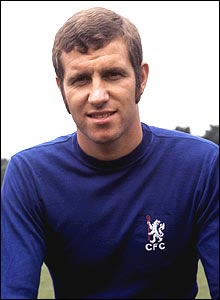 |
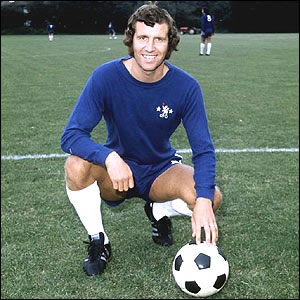 |
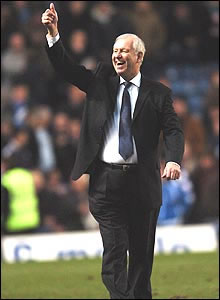 |
